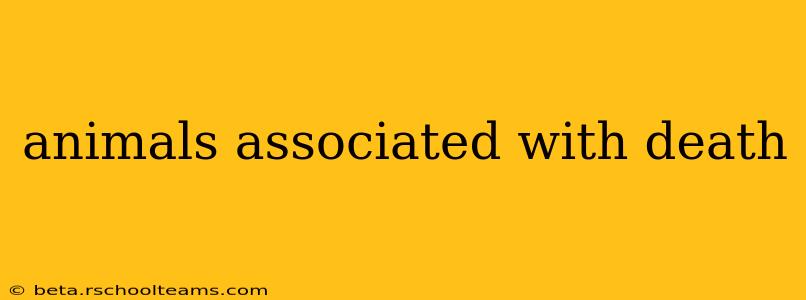Throughout history and across diverse cultures, certain animals have become strongly associated with death, the afterlife, and the transition between worlds. These associations aren't always negative; sometimes, these animals represent guidance, transformation, or the acceptance of mortality's inevitability. This exploration delves into the symbolism of various creatures linked to death, examining their cultural significance and the reasons behind their enduring presence in funerary rites and mythology.
Birds of Prey and the Grim Reaper: Ravens, Owls, and Vultures
Perhaps the most universally recognized death-associated animals are birds of prey. Ravens, with their dark plumage and haunting calls, frequently appear in folklore as messengers of death or omens of ill fortune. Their intelligence and scavenging nature contribute to this perception. Similarly, owls, often active at night, have long been linked to the unseen world and the mysteries of death. Their silent flight and nocturnal habits add to their enigmatic and somewhat spooky aura. Vultures, with their role in nature's cycle of decay, are understandably connected to death and decomposition, though their function is essential for ecological balance. In many cultures, they are seen as symbols of cleansing and the natural progression of life's end.
The Cultural Nuances:
- Celtic Mythology: Ravens played a significant role, often associated with both death and prophecy, acting as guides between the living and the dead.
- Native American Traditions: Different tribes held varying views, with some seeing owls as wise protectors of the spirit world, while others associated them with death and the underworld.
- Ancient Egypt: Vultures held a more positive association, representing protection, motherhood, and even the goddess Nekhbet.
Other Creatures of the Underworld: Snakes, Bats, and Black Cats
Beyond birds of prey, several other animals are frequently linked to death and the underworld. Snakes, with their shedding of skin, represent transformation and rebirth, but also often symbolize the dangerous and unseen forces of the world, frequently appearing in mythology as guardians of the underworld. Bats, with their nocturnal habits and association with caves and darkness, have earned a reputation as harbingers of misfortune and death. Their often misunderstood nature and connection to shadows contribute to this symbolism. Black cats, particularly in Western cultures, are commonly associated with bad luck and even death, stemming from superstitions and historical misinterpretations.
Understanding the Symbolism:
- Greek Mythology: The serpent was a powerful symbol, associated with both healing and death, embodying the duality of life and decay.
- Asian Cultures: Snakes hold diverse symbolism, with some viewing them as protectors and symbols of prosperity, while others associate them with negative forces.
- Medieval Europe: The association of black cats with witchcraft and evil significantly impacted their negative reputation.
Insects and Decay: The Role of Flies and Beetles
Certain insects, directly involved in the decomposition process, also possess strong associations with death. Flies, attracted to decaying matter, are naturally linked to death and decay. Similarly, some beetles, such as burying beetles, are involved in the decomposition of carcasses and are thus symbolically connected to death's process. While these associations may seem grim, they underscore the crucial role these creatures play in the natural cycle of life and death.
Beyond the Negative: Animals as Guides and Protectors
It's essential to remember that the symbolism of animals associated with death isn't always negative. In many cultures, these creatures act as guides for the souls of the departed, protectors of the dead, or symbols of transformation and rebirth. Their presence in funerary rites often signifies the transition to the afterlife, offering comfort and guidance during a difficult time. The interpretation of these symbols often depends heavily on the specific cultural context and beliefs.
Conclusion: Death's Animal Companions
The animals associated with death reflect humanity's enduring fascination with mortality, the afterlife, and the cycle of life. These creatures, whether feared or revered, hold a significant place in mythology, folklore, and religious practices worldwide. Their symbolism, while sometimes unsettling, offers a deeper understanding of human perspectives on death and the journey beyond. Further research into specific cultural traditions will reveal even more nuanced perspectives on the varied roles animals play in shaping our understanding of mortality.
